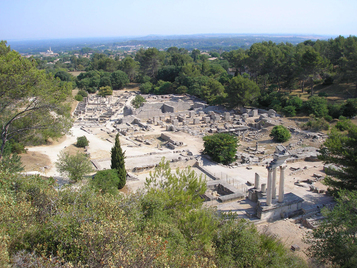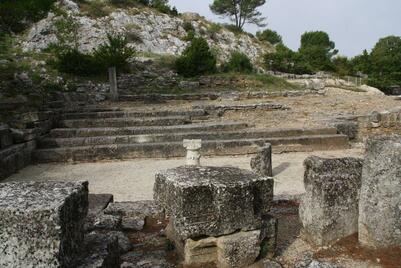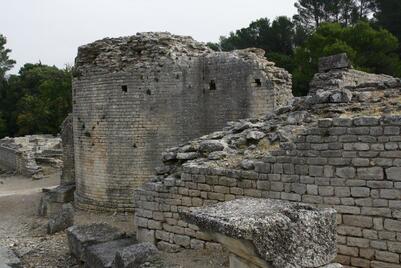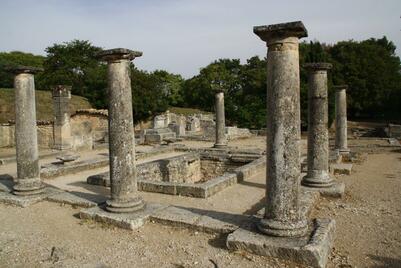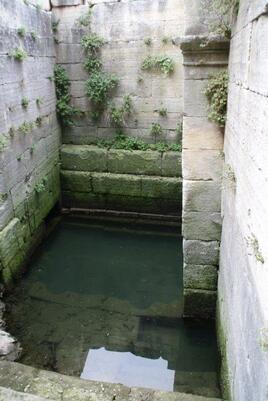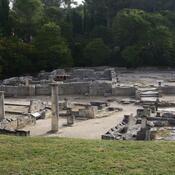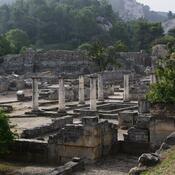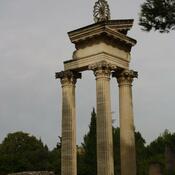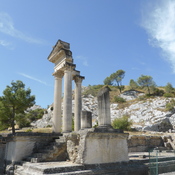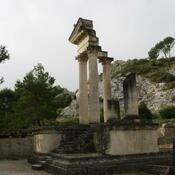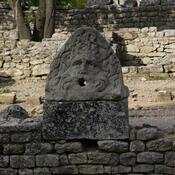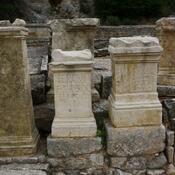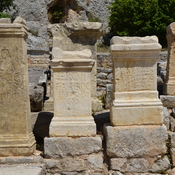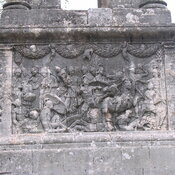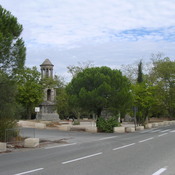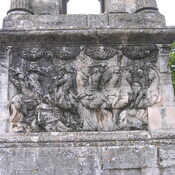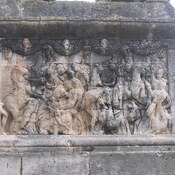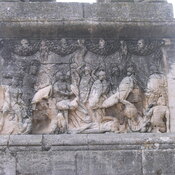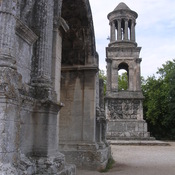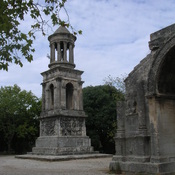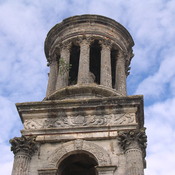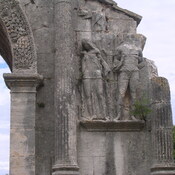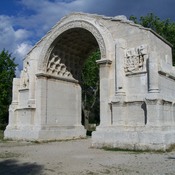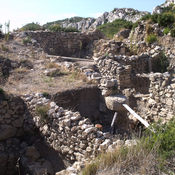Il n'y a pas une annotation en français. Présenté est une annotation en Anglais.
Glanum was an oppidum, or fortified town, founded by a Celto-Ligurian people called the Salyens in the 6th century BCE. It was known for the healing power of its spring. It became a Roman city in Provence until its abandonment in 260 AD. It is located on the flanks of the Alpilles, a range of mountains in the Bouches-du-Rhône département, about 20 km (12 mi) south of the modern city of Avignon, and a kilometre south of Saint-Rémy-de-Provence. It is particularly known for two well-preserved Roman monuments of the 1st century B.C., known as les Antiques, a mausoleum and a triumphal arch (the oldest in France).
Between the 4h and 2nd centuries B.C., the Salyens, the largest of the Celto-Ligurian tribes in Provence, built a rampart of stones on the peaks that surrounded the valley of Notre_Dame-de-Laval, and constructed an oppidum, or town, around the spring in the valley, which was known for its healing powers. A shrine was built at the spring to Glanis, a Celtic god. The town grew, and a second wall was built in the 2nd century.
The town had a strong Celtic identity, shown by the names of the residents (Vrittakos, Eporix, Litumaros) by the names of the local gods (Glanis and his companions, the Glanicae, (similar to the Roman Matres); and the goddesses Rosmerta and Epona); by the statues and pottery; by the customs, such as displaying the severed heads of enemies at the city gate; and by the cooking utensils found in the ruins, which showed that the people of Glanis boiled their food in pots, rather than frying it in pans like other Mediterranean tribes.
The people of Glanum were in early contact with the Greek colony of Marseille, which had been founded in about 600 B.C. The contact influenced the architecture and art of Glanum- villas were built in the Hellenic style. But by the 2nd century there conflicts and wars between the Salyens and the Greeks of Marseille. The Greeks of Marseille, not having a powerful army, called upon the assistance of their Roman allies. In 125 B.C. the Salyens were defeated by the army of the Roman consul Marcus Fulvius Flaccus, and the following year decisively defeated by C. Sextus Calvinus. Many of the old monuments of Glanum were destroyed,
Despite the defeat, the town prospered again, thanks to the attraction of the healing spring. The city produced its own silver coins and built new monuments. The prosperity lasted until 90 B.C. when the Salyens again rebelled against Rome. The rebellion was crushed again, this time by the Consul Caecilius, and the public buildings of Glanum were again destroyed. dismantled, and replaced by more modest structures.
In 49 B.C. Julius Caesar captured Marseille, and after a period of destructive civil wars, the Romanization of Provence and Glanum began. In 27 B.C. the Emperor Augustus created the Roman province of Gallia Narbonensis, and in this province Glanum was given the title of Oppidum Latinum, which gave residents the civil and political status of citizens of Rome. A triumphal arch was built outside the town between 10 and 25 B.C., near the end of the reign of Augustus, the first such arch to be built in Gaul, as well as an impressive mausoleum of the Julii family, both still standing.
In the 1st century B.C., under the Romans, the city built a new forum, temples, and a curved stone arch dam, Glanum Dam, the oldest known dam of its kind., and an aqueduct, which supplied water for the fountains and Roman baths in the town.
Glanum was not as prosperous as the Roman colonies of Arles, Avignon and Cavaillon, nor was it fortunate enough to be on the major Roman road of the colony, the Via Domitian, but in the 2nd century A.D. it was wealthy enough to build impressive shrines to the Emperors, to enlarge the forum, and to have extensive baths and other public buildings clad in marble.
Glanum did not survive the collapse of the Roman Empire. The town was overrun and destroyed by the Alamanni in 260 A.D., and was subsequently abandoned, its inhabitants moving a short distance north into the plain to found a city that later was named Saint-Rémy-de-Provence.
1Références
- ↑Wikipedia: Glanum
Glanum was an oppidum, or fortified town, founded by a Celto-Ligurian people called the Salyens in the 6th century BCE. It was known for the healing power of its spring. It became a Roman city in Provence until its abandonment in 260 AD. It is located on the flanks of the Alpilles, a range of mountains in the Bouches-du-Rhône département, about 20 km (12 mi) south of the modern city of Avignon, and a kilometre south of Saint-Rémy-de-Provence. It is particularly known for two well-preserved Roman monuments of the 1st century B.C., known as les Antiques, a mausoleum and a triumphal arch (the oldest in France).
Between the 4h and 2nd centuries B.C., the Salyens, the largest of the Celto-Ligurian tribes in Provence, built a rampart of stones on the peaks that surrounded the valley of Notre_Dame-de-Laval, and constructed an oppidum, or town, around the spring in the valley, which was known for its healing powers. A shrine was built at the spring to Glanis, a Celtic god. The town grew, and a second wall was built in the 2nd century.
The town had a strong Celtic identity, shown by the names of the residents (Vrittakos, Eporix, Litumaros) by the names of the local gods (Glanis and his companions, the Glanicae, (similar to the Roman Matres); and the goddesses Rosmerta and Epona); by the statues and pottery; by the customs, such as displaying the severed heads of enemies at the city gate; and by the cooking utensils found in the ruins, which showed that the people of Glanis boiled their food in pots, rather than frying it in pans like other Mediterranean tribes.
The people of Glanum were in early contact with the Greek colony of Marseille, which had been founded in about 600 B.C. The contact influenced the architecture and art of Glanum- villas were built in the Hellenic style. But by the 2nd century there conflicts and wars between the Salyens and the Greeks of Marseille. The Greeks of Marseille, not having a powerful army, called upon the assistance of their Roman allies. In 125 B.C. the Salyens were defeated by the army of the Roman consul Marcus Fulvius Flaccus, and the following year decisively defeated by C. Sextus Calvinus. Many of the old monuments of Glanum were destroyed,
Despite the defeat, the town prospered again, thanks to the attraction of the healing spring. The city produced its own silver coins and built new monuments. The prosperity lasted until 90 B.C. when the Salyens again rebelled against Rome. The rebellion was crushed again, this time by the Consul Caecilius, and the public buildings of Glanum were again destroyed. dismantled, and replaced by more modest structures.
In 49 B.C. Julius Caesar captured Marseille, and after a period of destructive civil wars, the Romanization of Provence and Glanum began. In 27 B.C. the Emperor Augustus created the Roman province of Gallia Narbonensis, and in this province Glanum was given the title of Oppidum Latinum, which gave residents the civil and political status of citizens of Rome. A triumphal arch was built outside the town between 10 and 25 B.C., near the end of the reign of Augustus, the first such arch to be built in Gaul, as well as an impressive mausoleum of the Julii family, both still standing.
In the 1st century B.C., under the Romans, the city built a new forum, temples, and a curved stone arch dam, Glanum Dam, the oldest known dam of its kind., and an aqueduct, which supplied water for the fountains and Roman baths in the town.
Glanum was not as prosperous as the Roman colonies of Arles, Avignon and Cavaillon, nor was it fortunate enough to be on the major Roman road of the colony, the Via Domitian, but in the 2nd century A.D. it was wealthy enough to build impressive shrines to the Emperors, to enlarge the forum, and to have extensive baths and other public buildings clad in marble.
Glanum did not survive the collapse of the Roman Empire. The town was overrun and destroyed by the Alamanni in 260 A.D., and was subsequently abandoned, its inhabitants moving a short distance north into the plain to found a city that later was named Saint-Rémy-de-Provence.
1Références
- ↑Wikipedia: Glanum
Glanum was een stad in de Romeinse provincie Provincia Narbonensis (de huidige Provence), in een dal van de Alpilles nabij het huidige Saint-Rémy-de-Provence.
Glanum is in de zesde eeuw voor Christus gesticht door de Gallische Kelten, en dankt haar ontstaan aan een heilige bron in een goed verdedigbare vallei. De Kelten bouwden eerst hun oppidum (vesting) op de naastgelegen Mont Gaussier (307 m.), maar daalden later naar de vallei af. De bron was gewijd aan de lokale god Glanis en drie moedergodinnen die later door de Romeinen Matres Glanicae werden genoemd.
Na de stichting van Massilia (Marseille) door de Grieken kwam Glanum onder de invloed van Griekse handelaren, die de Rhône opvoeren. Er werden munten geslagen met Griekse opschriften (ΓΛΑΝΙΚΩΝ, "van de Glanumers"), het Griekse alfabet werd overgenomen om het lokale Keltische dialect te schrijven, en de Griekse bouwstijl kwam in zwang: een trapezium-vormige agora, een bouleuterion (raadszaal) en een theater werden aangelegd. De ingang van de vallei werd met een imposante poort afgesloten.
Uit deze tijd dateren ook de eerste aangetroffen opschriften: grafschriften, de eerder genoemde munten, en inscripties van een mysterieuze cultus, de Boomdragers (δενδροφοροι Γλανικοι/dendrofori Glanici), die tot in de Romeinse tijd beleden werd.
Na de Romeinse verovering van de huidige Provence werd Glanum grondig gerenoveerd. De bron werd toegewijd aan de godin Valetudo, die werd vereerd omwille van een goede gezondheid. Het was een druk bezocht pelgrimsoord. De oude agora maakte in twee fases plaats voor een grandioos forum, en het hierdoor overbodig geworden bouleuterion maakte plaats voor twee tempels die gewijd waren aan de twee Prinsen der Jeugd (Gaius en Lucius Caesar, kleinzoons van keizer Augustus). Er werden grote publieke werken verricht; naast de genoemde tempels en het vergrote Forum ook thermen, tempels, een triomfboog en zelfs een grote stuwdam ten westen van de stad voor de watervoorziening van alle steden in de omgeving. De drainage van het stadsgebied, die voorheen in regenachtige tijden voor grote problemen zorgde, werd geregeld door een ingenieus rioleringssysteem onder de geplaveide hoofdstraat.
Het lijkt erop dat Glanum, dat een paar mijl van de grote weg tussen Italië en Spanje verwijderd lag, het vooral moest hebben van de broncultus: voor de handel lag het onhandig uit de route. In de derde eeuw na Christus ging het met de cultus bergafwaarts, en nadat de Alemannen de stad in 260 hadden verwoest, trokken de bewoners grotendeels weg uit het gebied; alleen rond de bron werden een paar nieuwe, kleine huizen gebouwd. Een paar kilometer verder naar het noorden werd een nieuwe stad gesticht, waarbij de vervallen gebouwen van Glanum dienden als bron voor bouwmaterialen. [Wikipedia: Glanum]

